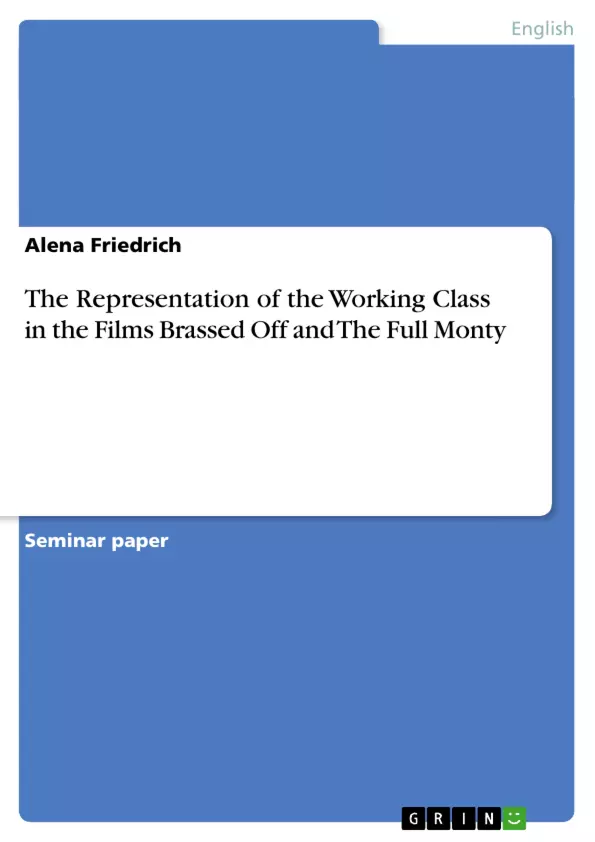Ziel dieser Arbeit ist es, die Darstellung der britischen Arbeiterklasse in den beiden Filmen 'Brassed Off' (Mark Herman, 1996) und 'The Full Monty' (Peter Cattaneo, 1997) zu analysieren. Insbesondere soll dabei auf die sozio-ökonomische Situation der Charaktere, deren soziale Beziehungen untereinander, den 'Working Class Pride and Traditionalism', die männliche Identifikation der Figuren und ihre regionale Verwurzelung eingegangen werden. Die zentralen Fragen, die sich dahingehend stellen, sind: Wie werden diese Aspekte in den Filmen dargestellt? Und inwiefern werden sie stereotypisiert dargestellt?
Diese Arbeit beruht auf der Annahme, dass die meisten Stereotype auf das traditionelle Bild der 'working class' des beginnenden 20. Jahrhunderts zurückgreifen. Aus diesem Grund wird diese Ära und ihr Einfluss auf das Leben der Arbeiter näher betrachtet, um dann Rückschlüsse auf die Repräsentation der Arbeiterklasse in 'Brassed Off' und 'The Full Monty' ziehen zu können.
This essay, which is going to analyse the representation of class in 'Brassed Off' and 'The Full Monty', will particularly focus on the typicality of the representations. It will analyse the characters' socio-economic situation, their social bonds, the 'working class pride and traditionalism', the workers' male identity and their regional identity. The central question will be, in which ways the films can be seen as "typical" working class motion pictures. In this respect, the stereotyping of the social classes in these two films will particularly be focused on.
This essay is based on the assumption that most stereotypes refer back to the traditional image of the working class as it existed at the beginning of the 20th century. In this context, it shall be analysed if the makers of 'Brassed Off' and 'The Full Monty' also used such stereotypes to produce an image of "the good old working class". In order to gain an understanding of these working class stereotypes, the first chapter of this paper will deal with the "old" working class as it existed at the turn of the 20th century and its main characteristics.
Inhaltsverzeichnis (Table of Contents)
- INTRODUCTION
- PART I. THE BRITISH WORKING CLASS IN THE COURSE OF THE 20TH CENTURY
- The "Old" Working Class
- The "New" Working Class
- Summary
- PART II. THE REPRESENTATION OF THE WORKING CLASS IN THE FILMS BRASSED OFF AND THE FULL MONTY
- The Characters' Socio-Economic Situation
- The Social Bonds
- Working class Pride and Traditionalism
- The Workers' Male Identity
- Regional Identity
- CONCLUSION
Zielsetzung und Themenschwerpunkte (Objectives and Key Themes)
This essay investigates the representation of the working class in the British films Brassed Off and The Full Monty, analyzing the ways in which these films present the social and economic realities of working-class individuals in the 1990s. The essay aims to explore the extent to which these films adhere to or challenge stereotypical representations of the working class, particularly in light of the changing socio-economic landscape of Britain during the late 20th century.
- The impact of economic changes, such as de-industrialisation and mass unemployment, on working-class communities.
- The portrayal of working-class identity in relation to traditional values, social bonds, and regional affiliation.
- The representation of the working-class experience in relation to gender, particularly the portrayal of working-class masculinity.
- The analysis of cinematic techniques and narrative elements used to portray working-class characters and their experiences.
- The comparison of these films to historical representations of the working class in British cinema and broader cultural contexts.
Zusammenfassung der Kapitel (Chapter Summaries)
The first chapter will focus on the "old" working class, examining its historical development and the key characteristics that defined it during the early 20th century. This analysis will provide a framework for understanding the traditional stereotypes associated with working-class culture.
The second chapter will delve into the emergence of the "new" working class, exploring the social and economic factors that transformed working-class communities in the latter half of the 20th century. This chapter will focus on the changing cultural landscape and the evolving representations of the working class in film and popular culture.
The subsequent chapters will analyze the representations of class in Brassed Off and The Full Monty, examining the films' depiction of the characters' socio-economic situation, their social bonds, their sense of working-class pride, and the role of gender and regional identity in their experiences. This analysis will draw on the previous discussions of the "old" and "new" working classes to assess the extent to which these films reinforce or challenge traditional stereotypes.
Schlüsselwörter (Keywords)
This analysis focuses on the representation of the working class in British film, specifically examining the films Brassed Off and The Full Monty. Key themes include working-class identity, de-industrialisation, unemployment, social bonds, regional identity, gender, and cinematic representation. The essay explores the historical context of the working class in Britain, drawing on concepts such as the "old" and "new" working classes, as well as broader discussions of class and stereotype in film and cultural studies.
- Quote paper
- Alena Friedrich (Author), 2003, The Representation of the Working Class in the Films Brassed Off and The Full Monty, Munich, GRIN Verlag, https://www.grin.com/document/14482



